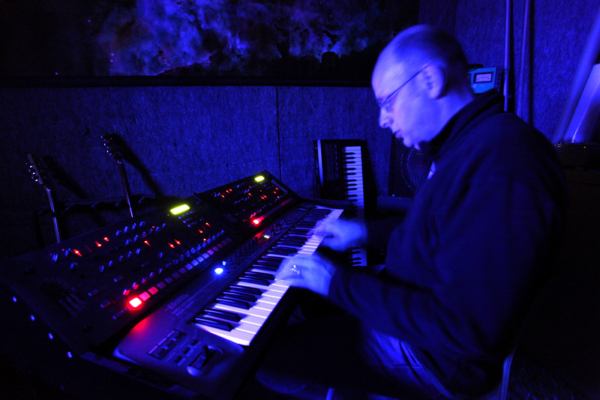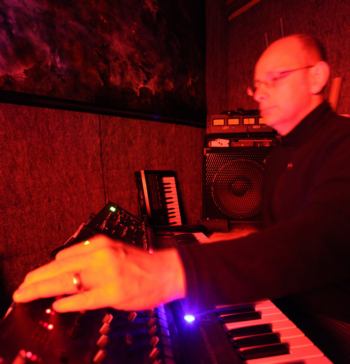Dweller through cinematic ambient landscapes and cosmic territories:
|
||
|
Steve, first of all do sketch a bit of a background on yourself as a person and as an electronic composer, as I only know your artist name originated from the Future Sound of London’s cd “Lifeforms”.. My first keyboard was a little Yamaha keyboard. The sort with various dance (I mean old style) rhythms built in. The first thing I did was put my guitar chorus pedal on the output to give me something “spacey”. So what happened next? With my interest in synthesisers growing I again “upgraded” to a Roland SH-5. This was the real deal. I still think it was a great synthesiser as I alas no longer own it. At the same time I bought a new Roland SH-101. Another great synthesiser which had a basic sequencer. What kind of music were you listening then? My main recording medium at this time was cassette and I had two reasonable quality machines. I would do multi-layered recordings by recording an initial line of a synthesiser on one cassette machine, then play that recording back via a mixer while performing the next line and recording the two lines to the second cassette machine. There was no computer-based recording abilities available and reel tape machines were expensive for me. You would not believe the sorts of tape noise levels I had to deal with, not to mention the artefacts caused by misaligned heads etc. I’d would now think of the effects created from the tape mechanism as an interesting effect whereas in those days I was strictly interested in layered melodic tunes and clean sounds. My only real source of new and different music in this electronic area was from two radio programs. One was Jaroslav Kovaricek’s “Dreamtime” and the other was “Scratching the Surface” hosted I believe by Andrew McLennan. Jaroslav’s program was ambient based and played lots of what I would now call new age music but he also played lots of “classical” pieces as well. I first heard Robert Rich’s “Cave Paintings” from the “Trances” release which was available on cassette at the time. I’ve noticed that you can get it on cd now. This was something I had never heard before. Not that I thought it was what I liked at the time. I was still into more melodic pieces. “Scratching the Surface” was more experimental including electro-acoustic pieces and field recordings which I was fascinated by but again at the time I didn’t really think of them in a musical sense. About this time I met some like minded people who had small studios based around synthesisers and started to learn a lot more about other composers out there. Though these peoples’ focus was more on synthesisers as parts of bands doing basically rock music there was lots to be learnt. I also expanded my abilities in the area of electronic construction. At this stage in life I felt that music was not going to be my main focus so in 1989 I started a Bachelor degree in Arts majoring in Film and Electronic Media. I decided that I’d like to work in the technical orientated side of the film industry. I also took on studies in electronic music and performance as electives. In my last year of study I took up a position in a news department at a local TV station which was at least a job in the industry. Meanwhile I also worked with a fellow graduate doing 3-D animation which led to both of us being employed by a specialist film production company whose focus was motion control camera equipment and production. During our time there we joined with two other fellow employees to create a new company that focussed on visual effects for film and TV. I was doing very little music at all. In fact it was probably the first time since the mid 80’s that I hadn’t been involved in some sort of band or production. My time was 110% focussed on the new visual effects company we had created. Several hard years later I realised that I didn’t want to spend the rest of my life working in the film industry. So in 1999 I decided to pack in the lucrative job in film, get myself a casual job to pay the bills and focus on creating music for myself to share with the world. Can you give an overview of the albums you made so far, and how the music on them compares to each other?
“Still Life” came next, and is really my first steps in experimental ambient music where I’ve started to concentrate on texture more than melody. Longer pieces that take the listener on a journey. There’s a big space theme running through this album which is something that continues with “Sacred Black”. I wouldn’t call it “Space” music as such. I’ve never quite got the hang of genres within “ambient” music as each person has there own ideas about what each genre sounds like. Many of my influences are places I’ve visited and stories I’ve heard. A big musical influence during this period was “Future Sound of London”. The sound scape stories that they told are to this day brilliant, in my opinion.
As previously mentioned, “Sacred Black” continues the space theme. Several track titles are from the writings of cosmologist, Carl Sagan. I was quite paranoid about this album as I was trying to fit myself into a mould by trying not to go against the grain with what I thought was the type of track that fitting this album from a listener’s perspective. My initial thoughts were that the pieces didn’t fit together very well. Later however I decided that I had invested too much time and effort into worrying about how people will perceive my work and realized this album gels together really well.
With my release “Auburn Silhouette” I decided that I no longer wanted to get stuck in a genre and that I shouldn’t “stay within the queue”. By this I mean the inclusion of essentially rock based tracks like “Hole in the Sky” and “Winter of the Falling Stars”, and yes that’s still the guitar I got when I was 14. This album is a lot more hi-fi as well due to the variations in textures being more dynamic in tone. I’m influenced by many styles of music and I like to bring some of those things that differentiate them into my work. The way I construct an album is a bit like a film. I like to think that whole album is one sound experience that people listen to as a whole. In reality I only split tracks up for radio play. If I was 100% confident in my work I would have one track per album…..
So what made you decide to make “Fragments”, a kind of remix-album based on Thus the idea of “Fragments” was to reflect those moments when sitting quietly going over your thoughts and memories. I have strong emotions connected with all my tracks and it’s interesting to me to hear what I’ve joined together from that emotion relationship along with a musical / textural relationship.
How does the process of starting a composition look like for you? Steve, your style varies across genres. Is there a reason for this? I think of my music fitting under the “ambient” genre which covers a vast area but having a similar experimental / ethereal sound. My influences are equally from rock music and electronic based music. I first started playing lead guitar in a band when I was 13, doing Shadows covers. I was always interested in the sound of the guitar, as much as the notes being played. This was also the period in my life when I would listen to a national music program called “Scratching the Surface” which played lots of experimental music. One piece that really intrigued me and also scared the hell out of me was Turkish composer, Ilhan Mimaroglu’s “Wings of the Delirious Demon”, created using the sounds of a tape recorder manipulated clarinet. The program also contained lots of electro-acoustic works of recreated scenes or landscapes which fascinated me and made me pay attention to all sorts of sounds. To me, your music also appears to be quite minimal… The old cliché that we live busy lives and need a place to escape to relax is something that I can certainly agree with. Though I don’t think I am really relaxed when I create music. It’s a different mind set that is wonderful when it happens – you’re onto something and you must keep going until you’ve finished the piece. Although what often happens is you hit a dead end. This is why I have lots of half finished pieces waiting for the dead end to be removed. Can you give an overview what sort of instrumentation you use?
The thing that makes composing on a computer so easy is the ability to recall previous work. I have a large amount of half completed works that need a certain state of mind and new ideas to complete them so having them up and running, ready to go on the computer at anytime is fantastic. I’ve also built several electronic gadgets that I use to create weird and wonderful noises with, of course these are all non digital pieces which have no sounds recall function. I use guitar in many pieces as well but mostly it is heavily effected to unintentionally disguise the instrument. I find the Ebow a great guitar ‘controller’ for creating long sustained sounds that allow for drone type music. Later on, you started including videos with your releases. What’s this all about ? My interests have lead me to build my own computer controlled time-lapse system which allows me to do this sort of thing whenever I have the time, which gives me great flexibility. It’s an expensive and time consuming adjunct to my music as I have to build the equipment, program the computers and test it but it’s part of the same thing for me. I haven’t including any visuals with “Fragments” as it’s up to the individual to visualize by themselves. Although I have been working on a live show while making “Fragments” which will now be a dvd. Please tell some more about this “live” dvd you’re working on… For this to work we needed to change the compositions to those that I had original recorded and I found that it would be as easy to include some new unused tracks as well since we were changing things. All was going well with rehearsals but we found the process of actually practicing the more minimal pieces to be very difficult especially for the other members who have come from rock orientated backgrounds. I was now four years into this which I was getting quite frustrated with and decided that it had to be completed as it was taking too long.
What made you compose and release music after all? Since I’m not a band that performs I need feedback from some other source. So the best approach for me is to get reviews written and have my music played on radio programs. For this I need to release my music. The idea of having a record company release my music is something I naively thought I would do when I recorded my first album but soon realized the area was changing and I decided that for my area of music self releasing was a better and only option. So what inspires you? I spend quite a lot of holiday time in remote locations within Australia especially the Flinders Ranges here in South Australia. Quite often I travel up to do time-lapse photography but also do bush walks and camp. I find that being in a quiet location with a vast panorama of hills and sparse vegetation to be very relaxing. There are no jet trails in the sky, no cars in the distance, just the sound of the blood traveling through your ears. The inspiration generated by this location is immense. I have a plan to do a Flinders Ranges suite as it were but I’ve yet to be convinced of a concept for it. Can you already reveal something of your future plans? Discography: 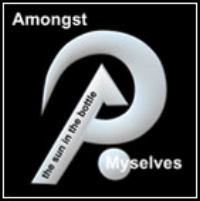
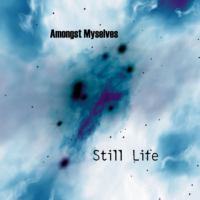
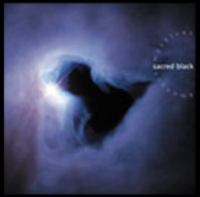

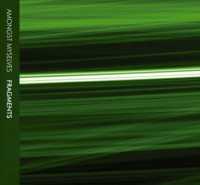
The track “Up into the Air and over the Edge” is a remixed version of the piece “Distant Horizons”, and can be found on the Ultima Thule compilation cd “Chasing the Dawn”. Website: www.amongstmyselves.com |
||

